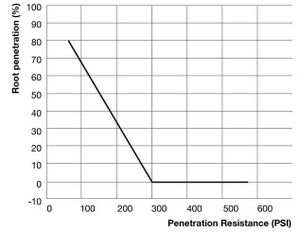
Difference between revisions of "Assessing soil health and function"
| Line 20: | Line 20: | ||
'''Assessment''' | '''Assessment''' | ||
There are multiple methods for measuring bulk density and compaction (resistance). See [https://stormwater.pca.state.mn.us/index.php?title=Soil_sampling_and_tests#Bulk_density methods for measuring] and [https://stormwater.pca.state.mn.us/index.php?title=Soil_sampling_and_tests#Compaction_.28penetration_resistance.29 methods for measuring compaction]. Recommended methods of assessment include the following. | There are multiple methods for measuring bulk density and compaction (resistance). See [https://stormwater.pca.state.mn.us/index.php?title=Soil_sampling_and_tests#Bulk_density methods for measuring] and [https://stormwater.pca.state.mn.us/index.php?title=Soil_sampling_and_tests#Compaction_.28penetration_resistance.29 methods for measuring compaction]. Recommended methods of assessment include the following. | ||
| − | *Penetrometer | + | *Penetrometer - a penetrometer is a portable, easy to use tool. The penetrometer is pushed into a soil and a gauge shows the resistance. Readings greater than 300 psi indicate conditions restrictive to root growth. If more than 50 percent of readings froma field exceed 300 psi, compaction is considered moderate; severe if more than 75 percent of readings exceed 300 psi. Typical cost of a penetrometer is about $200. |
| − | *Bulk density - Relationships of bulk density to root growth are shown in the adjacent table. | + | *Bulk density - bulk density is a relatively easy to perform measurement but requires determining the water (moisture) content of the soil. Relationships of bulk density to root growth are shown in the adjacent table. |
{{:General relationship of soil bulk density to root growth based on soil texture}} | {{:General relationship of soil bulk density to root growth based on soil texture}} | ||
Revision as of 17:38, 24 June 2021
Soil health is an assessment of how well soil performs all of its functions now and how those functions are being preserved for future use. The assessment of soil health depends on the desired functions of the soil. In agricultural applications, for example, soil health is determined by assessing properties that affect plant growth, such nutrient status, pH, and bulk density.
For stormwater applications, soil health can be assessed for the following functions.
- Ability to support vegetative growth
- Fully functioning soil ecology
- Supporting hydraulic/hydrologic function
- Ability to minimize erosion
Each of these is discussed below.
Ability to support vegetative growth
The following indicators can be used to assess suitability of a soil to support plant/vegetative growth.
Vegetative growth - Soil compaction (bulk density)

Importance: Soil compaction results from repeated traffic, generally from machinery, or repeated tillage at the same depth, which results in a compacted layer at the tillage depth. Compaction inhibits infiltration, gas and water movement, may impede root growth, disrupts habitat for soil biota, and affects nutrient cycling. See Soil physical properties and processes for a discussion of bulk density.
Assessment There are multiple methods for measuring bulk density and compaction (resistance). See methods for measuring and methods for measuring compaction. Recommended methods of assessment include the following.
- Penetrometer - a penetrometer is a portable, easy to use tool. The penetrometer is pushed into a soil and a gauge shows the resistance. Readings greater than 300 psi indicate conditions restrictive to root growth. If more than 50 percent of readings froma field exceed 300 psi, compaction is considered moderate; severe if more than 75 percent of readings exceed 300 psi. Typical cost of a penetrometer is about $200.
- Bulk density - bulk density is a relatively easy to perform measurement but requires determining the water (moisture) content of the soil. Relationships of bulk density to root growth are shown in the adjacent table.
General relationship of soil bulk density to root growth based on soil texture
Link to this table
| Soil texture | Ideal bulk densities (g/cm3) | Bulk densities that may affect plantgrowth (g/cm3) | Bulk densities that restrict root growth (g/cm3) |
|---|---|---|---|
| sands, loamy sands | <1.60 | 1.69 | >1.80 |
| sandy loams, loams | <1.40 | 1.63 | >1.80 |
| sandy clay loams, loams, clay loams | <1.40 | 1.60 | >1.75 |
| silts, silt loams | <1.30 | 1.60 | >1.75 |
| silt loams, silty clay loams | <1.40 | 1.55 | >1.65 |
| sandy clays, silty clays, clay loams with 35-45% clay | <1.10 | 1.49 | >1.58 |
| clays (>45% clay) | <1.10 | 1.39 | >1.47 |